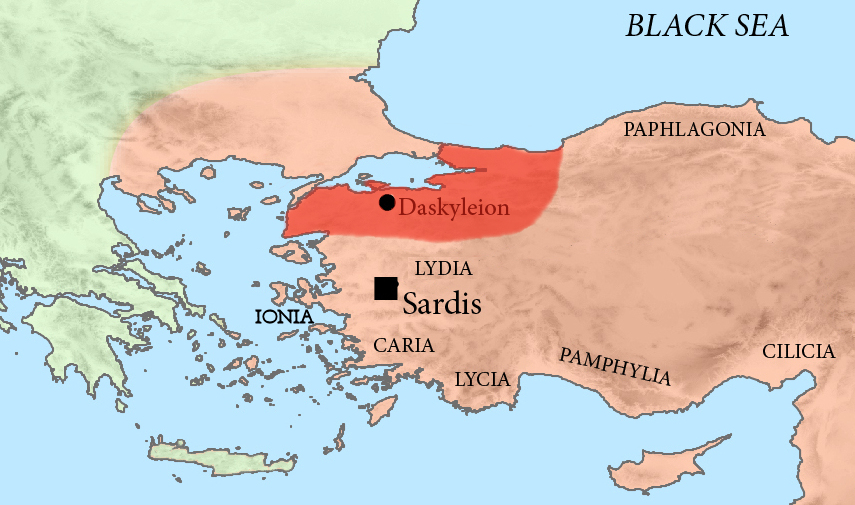|
Calas (general)
Calas or Callas (Greek Κάλας or Κάλλας; lived 4th century BC) was an ancient Greek, son of Harpalus of Elimiotis and first cousin to Antigonus, king of Asia. Asian campaign of Philip II Calas held a command in the army which Philip II sent into Anatolia under Parmenion and Attalus, 336 BC, to further his cause among the Greek cities there. In 335 BC Calas was defeated in a battle in the Troad by Memnon of Rhodes, but took refuge in Rhaeteum. Campaigns of Alexander the Great At the Battle of the Granicus in 334 BC he led the Thessalian cavalry in Alexander's army, and was appointed by him in the same year to the satrapy of the Lesser or Hellespontine Phrygia, to which Paphlagonia was soon after added. Excluding a failed attempt to conquer Bithynia, we do not hear of Calas: it would seem, however, that he died before the treason and flight of his father in 325, as we know from Arrian that Demarchus succeeded him in the satrapy of the Hellespontine Phrygia during Alex ... [...More Info...] [...Related Items...] OR: [Wikipedia] [Google] [Baidu] |
Hellespontine Phrygia
Hellespontine Phrygia ( grc, Ἑλλησποντιακὴ Φρυγία, Hellēspontiakē Phrygia) or Lesser Phrygia ( grc, μικρᾶ Φρυγία, mikra Phrygia) was a Persian satrapy (province) in northwestern Anatolia, directly southeast of the Hellespont. Its capital was Dascylium, and for most of its existence it was ruled by the hereditary Persian Pharnacid dynasty. Together with Greater Phrygia, it made up the administrative provinces of the wider Phrygia region. History The satrapy was created in the beginning of the fifth century BC, during the time of administrative reorganisations of the territories in western Asia Minor, which were amongst the most important Achaemenid territories. The first Achaemenid ruler of Hellespontine Phrygia was Mitrobates (ca. 525–522 BC), who was appointed by Cyrus the Great and continued under Cambises. He was killed and his territory absorbed by the satrap of neighbouring Lydia, Oroetes. Following the reorganization of Darius I, M ... [...More Info...] [...Related Items...] OR: [Wikipedia] [Google] [Baidu] |
Bithynia
Bithynia (; Koine Greek: , ''Bithynía'') was an ancient region, kingdom and Roman province in the northwest of Asia Minor (present-day Turkey), adjoining the Sea of Marmara, the Bosporus, and the Black Sea. It bordered Mysia to the southwest, Paphlagonia to the northeast along the Pontic coast, and Phrygia to the southeast towards the interior of Asia Minor. Bithynia was an independent kingdom from the 4th century BC. Its capital Nicomedia was rebuilt on the site of ancient Astacus in 264 BC by Nicomedes I of Bithynia. Bithynia was bequeathed to the Roman Republic in 74 BC, and became united with the Pontus region as the province of Bithynia et Pontus. In the 7th century it was incorporated into the Byzantine Opsikion theme. It became a border region to the Seljuk Empire in the 13th century, and was eventually conquered by the Ottoman Turks between 1325 and 1333. Description Several major cities sat on the fertile shores of the Propontis (which is now known as Sea o ... [...More Info...] [...Related Items...] OR: [Wikipedia] [Google] [Baidu] |
Ancient Elimiotes
Ancient history is a time period from the beginning of writing and recorded human history to as far as late antiquity. The span of recorded history is roughly 5,000 years, beginning with the Sumerian cuneiform script. Ancient history covers all continents inhabited by humans in the period 3000 BCAD 500. The three-age system periodizes ancient history into the Stone Age, the Bronze Age, and the Iron Age, with recorded history generally considered to begin with the Bronze Age. The start and end of the three ages varies between world regions. In many regions the Bronze Age is generally considered to begin a few centuries prior to 3000 BC, while the end of the Iron Age varies from the early first millennium BC in some regions to the late first millennium AD in others. During the time period of ancient history, the world population was already exponentially increasing due to the Neolithic Revolution, which was in full progress. While in 10,000 BC, the world population stood ... [...More Info...] [...Related Items...] OR: [Wikipedia] [Google] [Baidu] |



